When it comes to poker, understanding the different types of hands is vital for playing effectively and strategizing your moves. Poker is more than just a game of chance; it requires skill, knowledge, and strategy. In this article, we will break down the various poker hands simply, creating an easytofollow reference that will help you improve your gameplay. Additionally, we will highlight five specific tips to enhance your productivity and decisionmaking skills while playing poker.
Types of Poker Hands
Poker hands are ranked by the rarity of the combination of cards you hold. The higher the rank, the stronger the hand, giving you a better opportunity to win. Here’s a breakdown of poker hands, from highest to lowest:
A royal flush is the highest hand in poker and consists of the Ace, King, Queen, Jack, and Ten, all of the same suit.

Example: A♠ K♠ Q♠ J♠ 10♠
A straight flush is five consecutive cards of the same suit.
Example: 9♦ 8♦ 7♦ 6♦ 5♦
This hand consists of four cards of the same rank, along with one additional card (the kicker).
Example: 7♣ 7♦ 7♥ 7♠ 2♦
A full house is a combination of three of a kind and a pair.
Example: K♣ K♦ K♠ 3♥ 3♣
A flush consists of five cards of the same suit, not in numeric order.
Example: A♣ 10♣ 7♣ 5♣ 2♣
A straight is made up of five consecutive cards of different suits.
Example: 10♠ 9♦ 8♥ 7♣ 6♦
This hand consists of three cards of the same rank along with two unrelated cards.
Example: Q♦ Q♣ Q♠ 5♥ 4♦
A two pair hand consists of two cards of one rank, two cards of another rank, and one unrelated card.
Example: J♣ J♦ 4♣ 4♥ 3♠
This hand contains two cards of the same rank and three unrelated cards.
Example: A♥ A♠ 6♣ 5♦ 4☘️
When no players have any of the above combinations, the winner is determined by the highest card held.
Example: K♣ 10♠ 9♥ 5♣ 3♦ (K♣ is the high card)
Tips to Improve Your Poker Game
Understanding the hands is essential, but how you execute your knowledge makes a difference. Here are five productivityenhancing tips to help you improve your poker game.
Knowing when to fold is just as crucial as knowing when to play aggressively. If you have a lowranking hand or face difficult community cards, folding may save you from unnecessary losses.
Application: In a situation where you have a Pair of Twos and the board shows higher cards, it might be wise to fold if you're facing a strong bet.
Observing your opponents' behavior and betting patterns provides valuable insights into their possible hands.
Application: If you notice that a player raises often when they have a strong hand, you can adjust your strategy to counter their aggression.
Managing the size of the pot can influence the amount you risk. If you're unsure about your hand's strength, consider keeping the pot smaller.
Application: If you have a decent hand but are uncertain about other players, make smaller bets to avoid inflating the pot too much.
Good bankroll management prevents you from going broke. Set limits on your betting and stay disciplined with your spending.
Application: If you decide to bet 5% of your total bankroll on a single session, ensure you stick to that limit even when temptation arises.
Utilize online tools or applications that simulate poker hands and strategies. These can help you practice and understand the game dynamics better.
Application: Use poker equity calculators to evaluate how your hand fares against possible opponent hands.
Frequently Asked Questions (FAQs)
The best starting hand in Texas Hold’em poker is pocket Aces (A♠ A♦). This hand has the highest probability of winning against any other starting hand preflop. However, while they are the strongest starting hand, maintain a strategy that adjusts according to community cards for optimal performance.
To determine if you have a good hand, compare your cards against the hand rankings and evaluate the community cards. A strong hand is often a combination of pairs, sets, or draws that can lead to better hands based on the flop, turn, and river.
If you have a weak hand, it is usually best to fold unless you possess strong situational awareness and can bluff successfully. Keeping track of other players’ betting patterns educates you on when to take risks or exit a hand early.
Yes, your position at the table significantly influences your gameplay strategy. Players positioned later have the advantage of observing opponents’ actions before making decisions, allowing for more informed plays. Use this to your benefit, especially when holding marginal hands.
Bluffing can be an effective tactic, but it’s essential to use it sparingly and strategically. Bluffing frequently can lead to losing credibility at the table. Successful bluffing relies on understanding your opponents and predicting their reactions based on the board.
Building your poker skills involves practice and continual learning. Engage in regular games, study strategies from books and videos, and participate in online forums. Tools like poker training sites can provide additional insights to sharpen your strategies and decisionmaking.
A strong foundation in understanding poker hands is essential for enhancing your game. Equally important are practical tips that can elevate your decisionmaking and strategic capabilities. By implementing the advice outlined in this article, you can progressively refine your poker skills and maximize your chances of success at the table. Remember, poker is not just about the cards in your hand but about how you play them. Happy playing!